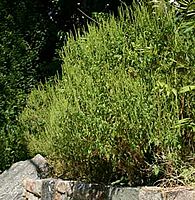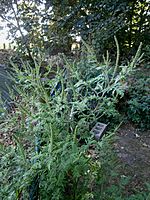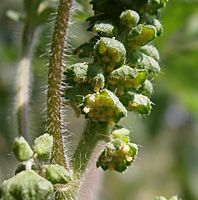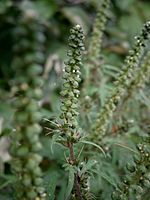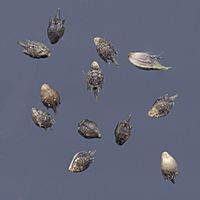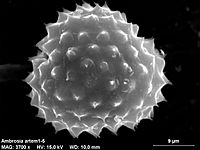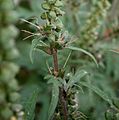Ambrosia artemisiifolia facts for kids
Quick facts for kids Ambrosia artemisiifolia |
|
|---|---|
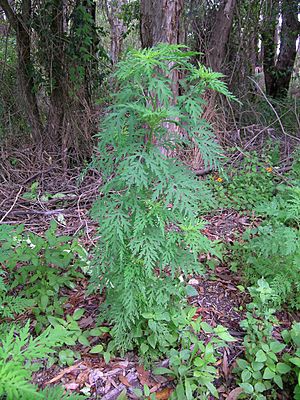 |
|
| Scientific classification | |
| Genus: |
Ambrosia
|
| Species: |
artemisiifolia
|
| Synonyms | |
|
|
Ambrosia artemisiifolia, also known as common ragweed, is a plant found in many parts of the Americas. It is also called annual ragweed or low ragweed. This plant is well-known because its pollen can cause hay fever in many people.
Contents
About the Name
The scientific name, artemisiifolia, means "leaves like Artemisia". People thought its leaves looked similar to those of the Artemisia plant, which includes wormwoods.
This plant has many other common names. Some of these are American wormwood, bitterweed, carrot weed, and hay fever weed.
Where it Grows
Common ragweed is originally from North America. It grows across Canada, the eastern and central United States, and Alaska. You can also find it in the Caribbean (like Cuba and Jamaica) and in South America (including Argentina and Brazil).
It is the most common type of Ambrosia plant in North America. Scientists believe it will spread even more in Europe in the future. During summer, especially in August, its pollen causes many allergic reactions.
What it Looks Like
Common ragweed is an annual plant. This means it grows, flowers, and dies within one year. It usually starts growing in late spring.
The plant can grow up to 70 centimeters (about 2.3 feet) tall. It has many branches. Its leaves are soft and hairy, measuring about 3 to 12 centimeters (1 to 5 inches) long. They are deeply divided, almost like a fern.
Ragweed blooms from July to October in North America. Its tiny pollen grains are carried by the wind. This wind-blown pollen is a strong allergen, which means it can cause hay fever symptoms in people who are sensitive to it.
The plant produces small, green to brown fruits, about 2–4 millimeters long. These fruits contain seeds. The seeds are numerous and full of oil. Because of this, many songbirds and game birds like to eat them during winter.
A Spreading Plant
Common ragweed is known as a widespread invasive species. This means it grows quickly and can take over areas where it isn't native. It has spread to Europe, Asia, Africa, Australia, New Zealand, and Hawaii.
This plant is a very strong weed. It can cause big problems for farmers. For example, it can reduce soybean crops by as much as 30 percent. Farmers try different ways to control it. Plowing fields at night can reduce how much ragweed grows. Planting small grains with clover can also help keep it from growing too much.
Its wind-blown pollen is a major cause of allergies for many people.
Controlling Ragweed
People use different methods to control common ragweed. As of 2005, several herbicides (chemicals that kill plants) were effective. However, some ragweed plants have become resistant to these chemicals. For example, by 2007, some ragweed in the USA had become resistant to a common herbicide called glyphosate.
Scientists are also looking for natural ways to control ragweed. Since 2014, a type of beetle called the ragweed leaf beetle (Ophraella communa) has been found in southern Switzerland and northern Italy. These beetles eat ragweed leaves, sometimes completely destroying the plants. Another beetle, Zygogramma suturalis, was brought to Russia and China to help control ragweed, with good results.
There is also a European group called SMARTER. It brings together experts from different fields to find better ways to control ragweed. This includes health experts, scientists who study pollen, farmers, and economists.
Uses of Ragweed
Even though ragweed causes allergies, it has some interesting uses.
Natural Chemicals and Snails
Scientists have found special chemicals called sesquiterpene lactones in the upper parts of the ragweed plant. Some of these chemicals can kill certain types of snails, like the small freshwater snail Oncomelania hupensis.
Traditional Medicine
Ambrosia artemisiifolia has been used as a traditional medicinal plant by several Native American tribes. Tribes like the Cherokee, Lakota, Iroquois, and Delaware used it for various health purposes.
Cleaning Up Soil
Ragweed can also be used in projects called phytoremediation. This is a way to clean up polluted soil using plants. Ambrosia artemisiifolia can help remove heavy metals, like lead, from soil that has been contaminated.
Gallery
Images for kids
See also
 In Spanish: Ambrosia artemisiifolia para niños
In Spanish: Ambrosia artemisiifolia para niños


